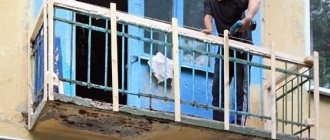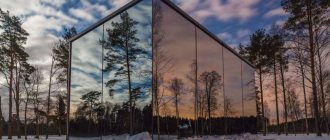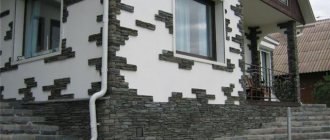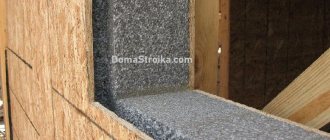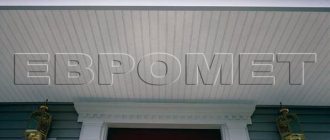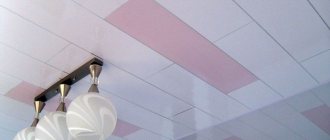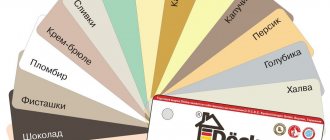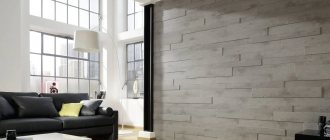Facade panels for plaster
Plastered facades look noble and interesting, but high-quality plaster takes time. When time is of the essence and the budget is limited, facade panels for plaster will help out. Unlike traditional technology using a sand-cement mixture, they do not have some disadvantages. These include labor intensity and the likelihood of cracks appearing during the shrinkage process.
Figure 1. Facade panels for plaster
Plastered panels for exterior finishing
Finishing the facade with panels for plaster helps to avoid risks associated with the human factor. If the finisher's skill leaves much to be desired, the drawing may turn out distorted. In this case, the facade will not look neat. Facade panels reduce such moments to a minimum. Even a non-professional can handle them.
These are the results that modern cellulose-based finishing materials can achieve.
A beautiful combination of beige and brown cladding with rustic stone decorating the corners of the building.
Figure 2. Combination of beige and brown cladding
Stylish architectural accents, which were achieved through the use of light and dark colored panels.
Figure 3. Using panels of light and dark colors
A combination of white and Venetian plaster using panels from the Japanese brand “Torey”.
Figure 4. Combination of white and Venetian plaster
Composition and characteristics of fiber cement panels
Fiber cement panels consist of cement, cellulose fibers and sand. Cellulose makes up only 10-15 percent of the composition. It prevents siding from warping and cracking under environmental influences. The use of mica, polymers and other additives is allowed.
A typical panel includes the following components:
- fiber cement board - it occupies the central part of the product;
- water repellent – water-repellent primer covering the inner surface and sides;
- weather-resistant decorative coating - the outer layer of the required colors and texture.
Fiber cement is good because on its surface you can imitate any finishing building material: from mahogany and Venetian plaster, to rock and clinker brick. At the same time, there is no need to be afraid that the decorative layer will peel off over time. Quality products will last for decades.
Types of facade panels for plaster
The plaster facade of a house can take on hundreds of different appearances. It all depends on the type of facade slabs chosen. Each material has its own recognizable features. Let's consider the existing types of facade panels.
Fiber cement siding is an affordable composite material that allows you to design the exterior of a building in a given style. It can have the texture of concrete, brick, rock, wooden boards and natural stone.
An alternative to it are thermal panels, which are made of two or three layers. They not only give beauty to the facade, but also additionally insulate it. Depending on the insulation used, thermal panels with polystyrene, mineral wool, and polyurethane foam are distinguished.
Depending on the type of finishing, panels are divided into ceramic slabs, clinker bricks, mosaics, torn stone, natural stone, brick, wood, etc.
Depending on the scope of application, panels are divided into facade and basement. The latter type can be used both locally and for finishing the entire building. Basement siding has increased strength characteristics.
Advantages of fiber cement panels for plastering
Fiber cement boards consist of wood fiber, mica, quartz, cement, and inorganic components. Several layers of material are pressed under high pressure and at elevated temperatures in an autoclave. The result is a monolithic material with a homogeneous structure. It has the following advantages:
- Panels for plaster based on wood fiber do not support combustion because they are made from non-combustible components. Can withstand prolonged exposure to high temperatures without any damage.
- Do not contain harmful substances, including asbestos. The main component is cellulose fiber, a natural material. Completely safe for human health and the environment.
- They are a durable facing material. They are not afraid of mechanical damage, including hail, due to the multilayer structure.
- They look beautiful and expensive. You can choose any color - there are no restrictions. Thanks to the variety of color and texture solutions, they help in realizing bold architectural designs.
- They are not afraid of water and dampness, as they are painted with acrylic paint on both sides - outer and inner.
- They can be mounted in different ways (with dowels, glue, or regular nails).
- They are not afraid of frost.
- They serve for an average of 25 years.
I don't want a tree! Which siding should I choose for the facade of my house?
Kuminova Irina Nikolaevna head of construction and installation work
This question often arises when finishing a facade. Of course, choosing the appropriate material can sometimes be very difficult.
After all, everyone wants it to be spectacular, beautiful, reliable, of high quality and have a long service life.
And another important factor is the price of the issue, preferably not high, not ruining the budget.
What will you learn about in the article?
- What fiber cement siding do we recommend?
- How panels differ from each other in profile
- How does fiber cement siding differ in texture?
- How is fiber cement siding installed?
Someone will think that this is beyond fantasy, but it’s not.
Natural wooden panels are undoubtedly excellent, but they require proper care and attention, which sometimes costs a significant amount of money for the home owner.
Photo 1. Fiber cement siding “Cedral”
What fiber cement siding do we recommend?
“Cedral” was created
. What kind of new product is this, this is what we will discuss in our article today.
Fiber cement panels are considered one of the newest and most modern types of building finishing products, they have high strength, which does not depend on temperature and aggressive weather conditions, they are distinguished by a variety of colors, a very attractive structure, reminiscent of natural wood, or, if you want a facade with plaster, then her.
Photo 2. House covered with “Cedral” siding
The material is produced from composite cement, sand, water, cellulose fibers, additives and fillers that can withstand the effects of ultraviolet rays and dampness. All these elements ensure this material is environmentally friendly and safe for humans and the environment. These panels can be confidently classified as modern, safe materials of the new generation.
Photo 3. “Cedral Wood”
Fiber cement panels for facade cladding are endowed with a number of distinctive positive qualities, thanks to which the products have occupied a large part of the market:
- Long-term operation. The panels, regardless of natural manifestations, last at least 50 years.
- They are not afraid of changes in weather and climate, changing seasons, jumps in temperature amplitudes; unlike wooden materials, they are not susceptible to rot, mold, mildew, corrosion, the onslaught of insects, rodents and other pests.
- Ultraviolet rays are not so destructive to the surface of products and the panels do not shrink from high heat, do not crack, or deform.
- High thermal insulation properties and the ability to muffle extraneous noise. In our difficult times, when energy prices rise monthly, it is worth paying special attention to thermal insulation. It is this fact that served as a compelling reason for many owners to purchase fiber cement siding in order to save on thermal energy consumption and reduce the cost of maintaining a comfortable environment in the house.
- Simple installation that does not require special expensive equipment. The panels are laid in several ways, depending on the selected siding profile. No preliminary work is required. All flaws and errors will be safely hidden under the finishing panels.
- Environmentally friendly material. All components are absolutely harmless to human health.
- Wide color palette, imitation of the natural texture of cedar or plastered surface. If you need to convey a certain color to the finish, to blend harmoniously with the environment, fiber cement siding is the ideal choice.
- Just keep it clean. Thanks to the special structure, dirt and dust cannot clog into the pores, but remain on the surface of the panel and are washed off during rain, which plays a huge role in the fact that the color practically does not fade and does not “age”, as it were.
- A very important factor, in contrast to natural wooden panels, is resistance to fire and critically high temperatures. The products are non-flammable and do not lose their appearance or shape in direct contact with open fire.
- The panels are lightweight, they do not create pressure on the main foundation, but will provide the most optimal load on the external walls of the building.
Before you go and purchase panels, you need to know their features and only then make your choice.
How panels differ from each other in profile
Cedral Click
with a latch, mounted in a quarter, and
Cedral
, without a latch, mounted as a herringbone.
“Click” allows you to implement almost any project and architectural ideas in the design of external walls, giving them a bright, original, unique appearance.
Cedral Click panels are equipped with a special “latch”, this increases installation speed, saves time and does not require any additional effort. The boards are quite simply attached to each other using a clamp, creating a monolithic, beautiful surface.
Cedral Click
can be mounted not only horizontally, but also vertically. There are two types of surface of this siding:
- smooth board, thanks to which many architectural fantasies can be realized;
- boards with a textured surface, imitation of natural wood products, which allows you to decorate the facade “like wood” and avoid all the “inconveniences” associated with the use of natural wood (no knots, resin pockets, the finish does not dry out, everything is smooth).
Photo 4. Decorating the house with “Cedral” siding
Also pay attention to the
Kedral
. Unlike the above material, they are mounted only end-to-end or overlapped and do not have a latch.
How does fiber cement siding differ in texture?
Cedral panels are produced in two types:
- Cedral Wood
– with a surface imitating the natural texture of cedar; - Cedral Smooth
– under plaster.
Now all you have to do is choose the look you like best and decide on the color. The material was tested in difficult, aggressive natural conditions and withstood them perfectly, test reports confirm this.
Photo 5. Fiber cement siding “Cedral”
With the help of fiber cement siding, you can build a hinged, ventilated facade that reliably protects the main walls from adverse external factors, as well as give the house a completely unique, memorable appearance.
How is fiber cement siding installed?
Very simple. Even easier than planken. The panels are laid horizontally or vertically. It should be taken into account that vertically laid panels optically increase the height of the entire house.
This effect is very relevant if you are cladding the facade of old, low, squat buildings. Horizontal and vertical installation differ from each other in the sequence of construction of the sheathing frame.
Photo 6. Siding on the facade of the house
When laying panels horizontally, the sheathing is installed vertically. And when laying vertically, everything is in the reverse order: the bars are attached to the wall horizontally.
The entire installation is divided into the following stages:
- fastening the sheathing bars to the facade wall;
- laying vapor barrier;
- Insulation boards are laid between the bars;
- wind protection is stretched - a membrane film that protects the insulation from moisture;
- counter lathing made of planed bars 50x20;
- installation of panels with self-tapping screws.
Laying siding, depending on the chosen profile, is done overlapping or end-to-end, using self-tapping screws with an anti-corrosion coating or in a hidden way using special clamps.
For decoration, you can use various additional elements in the form of overlays on corners, window slopes, doorways, etc. The use of various decorative accessories enhances aesthetic perception.
Photo 7. Our work on installation of Kedral
For lathing, antiseptic pine bars are usually used, dried in thermal modules and having a moisture content of no more than 15%. For lathing from 40 to 50 mm or 50x50 mm, for control lathing 50x20 mm or 40x20 mm.
In order to ensure proper ventilation to the main walls of the building, a space of 2 cm must be left below; do not worry, it will be hidden under the profile sheet. Perforation will provide the necessary ventilation, and the top sheet will serve as a barrier for rodents to get under the façade cladding.
Photo 8. Installation of Kedral
Siding is not “afraid” of either heat or cold, and in this it certainly wins over products made from natural wood. It will not create noise when it rains and will not disturb the sleep of the home owners. Fiber cement siding allows you to forget about upcoming repair and finishing work for decades!
If the customer wishes, we will carry out professional installation of fiber cement siding panels from leading manufacturers on the façade of your home, ensuring the high quality of all work performed. We will ensure that your home looks presentable and will be the envy of your neighbors.
See how we can
December 24, 2019 689
House facade made from CEDRAL fiber cement panels
120 m2 720 000
23 days from. "Ivanovskoe"
December 04, 2019 581
Finishing the facade with SmartSaide siding and fencing for the veranda
210 m2 1 470 000
24 days SNT "Zvezda"
April 25, 2019 1067
House in the "Chalet" style with turnkey finishing in the forest landscape complex
7.9x8.9 m 6 700 000
51 days of CP “Forest Landscape”
View other works
Dimensions of facade panels for plaster
Fiber cement panels are represented on the market by several manufacturers. The surface sizes of each of them are slightly different. Let's look at the dimensions of the slabs of the most famous brands on the market.
Fiber cement boards KMEW
| Series | Texture | Size |
| NT3853GA Neorok | Wild stone | 16Х3030Х455 mm |
| NF5161U Neorok | Burnt brick | 18Х3030Х455 mm |
| F3644JU Neorok | Masonry | 16Х3030Х455 mm |
| RZ5100C Ceradir | Wood | 18Х3030Х455 mm |
| COAT CL4101C Ceradir POWER | Bricklaying | 16Х3030Х455 mm |
| CA12511C Ceradir-akril | Decorative plaster | 14Х3030Х455 mm |
| CA1842WC Ceradir-akril | Decorative plaster | 14Х3030Х910 mm |
Nichiha fiber cement curtain panels
| Series | Texture | Size |
| AE811 | Masonry | 0.035Х0.455Х0.22 mm |
| AY41 | Wild stone | 0.035Х0.455Х0.22 mm |
| EJ58 | Masonry | 0.018Х0.455Х1.818 mm |
| EF86 | Sawed stone | 0.018Х0.455Х1.818 mm |
| EFX135 | Modern | 0.016Х0.455Х3.03 mm |
| EF76 | Wooden lining | 0.016Х0.455Х3.03 mm |
| WDX32 | Natural stone | 0.014Х0.455Х3.03 mm |
Fiber cement boards for A-Stone plaster
| Series | Texture | Size |
| AS–701-704 | Vinyl siding | 15Х615Х3000 mm |
| AS–401-403 | Masonry | 15Х600Х3000 m |
| AS–601-603 | Board | 15Х600Х3000 mm |
| AS–101-103 | Wild stone | 12Х615Х3000 mm |
| AS–301-317 | Brickwork | 12Х615Х3000 mm |
| AS–201-203 | Decorative plaster | 10Х1220Х3000 mm |
Where to buy and how much do finishing facade materials cost?
You can purchase fiber cement cladding on the construction market, in a specialized store, or order it online. The cost of modern panels depends on the specific manufacturer, the thickness of the product, its quality, model, and the work of the craftsman. Below is a table with average price indicators for Russian cities.
| Trademark | Price per square meter (rubles) |
| Nichiha | From 1000 to 3000 |
| Minerit | 700-3000 |
| Kmew | From 1000 |
| Rospan | From 600 |
| Eternit | From 1200 |
| A-Stone | From 850 |
Do-it-yourself panel installation
When covering the facade with panels for plaster with your own hands, you need to do the following:
Figure 5. Sequence when cladding the facade with panels for plaster with your own hands
The set of components for installation work is standard and includes pliers, a screwdriver, an angle grinder, and a screwdriver. The frame can be metal or wood. If you choose a tree, take care of its additional protection from destruction.
The frame guides should be installed at a distance not exceeding 60 cm from each other. For fastening slabs up to 14 mm thick, nails or self-tapping screws are most often used. Upon completion of the work, their hats are painted to match the color of the cladding. The plates themselves are applied with a gap of 10 mm. It must be filled with a sealing compound.
If the installation involves slabs with a thickness of 16 mm, clamps are used to achieve reliable fastening. They allow you to get a neat result and ensure that seams and fastenings are not visible.
IMPORTANT: Fiber cement siding is environmentally friendly, but the dust that is generated when cutting it poses a respiratory hazard. In this regard, it is necessary to cut slabs outdoors. When working, be sure to protect your face with a mask and goggles, and your hands with gloves.
Training video on installation of facade panels.
